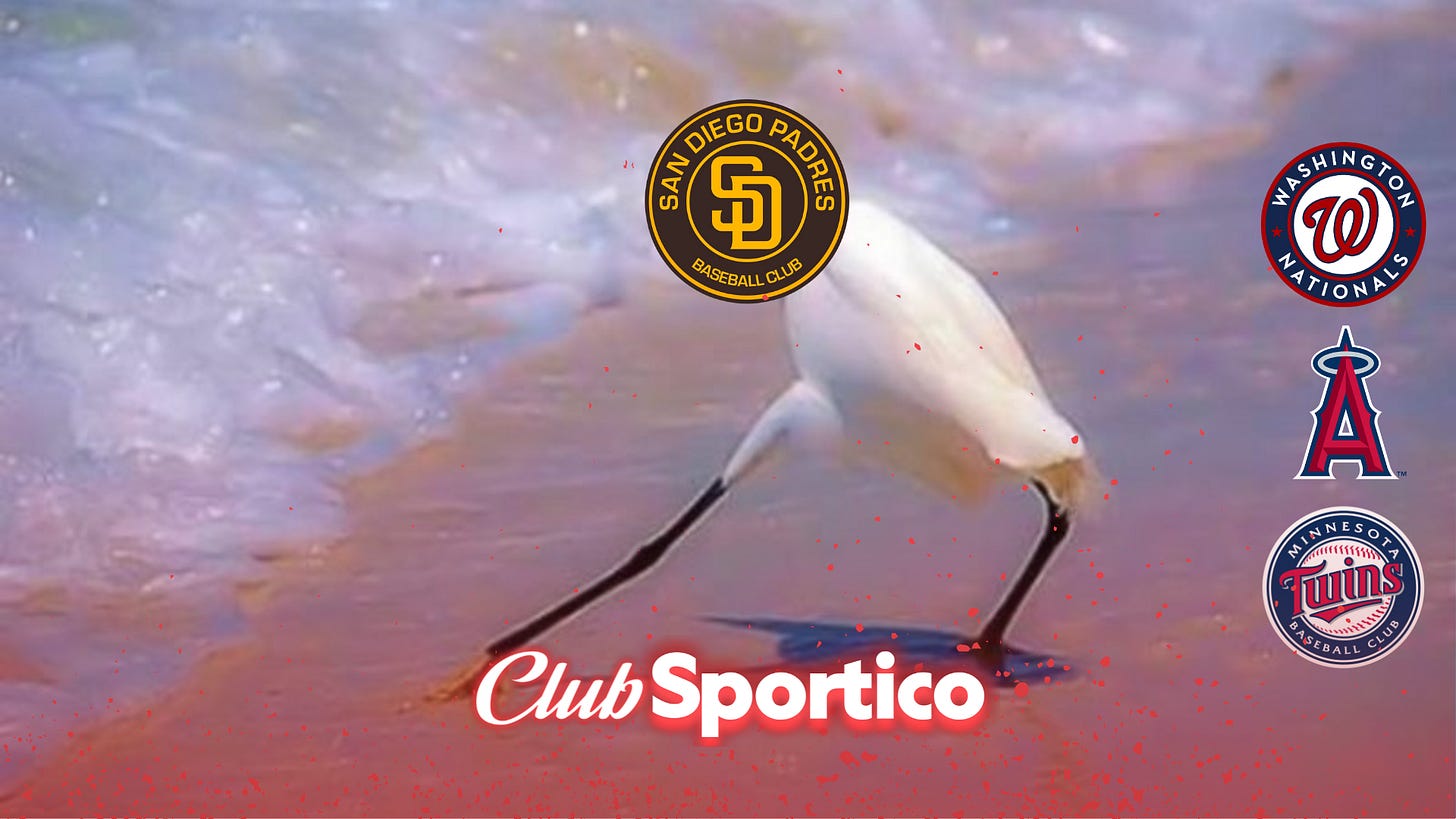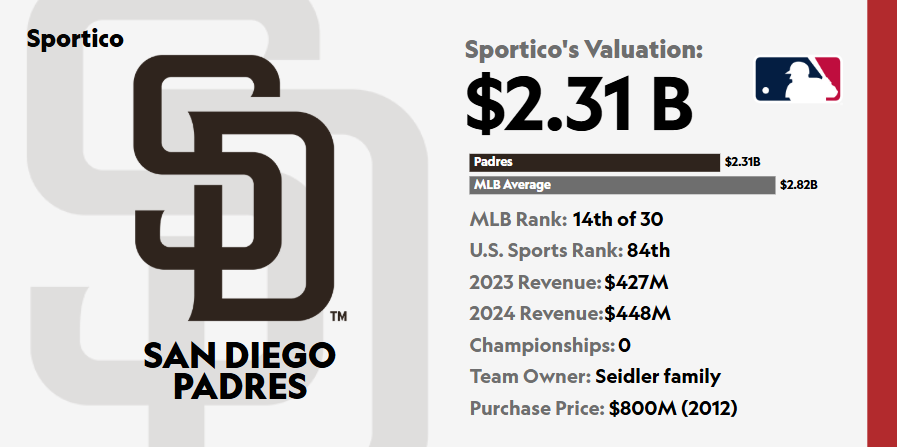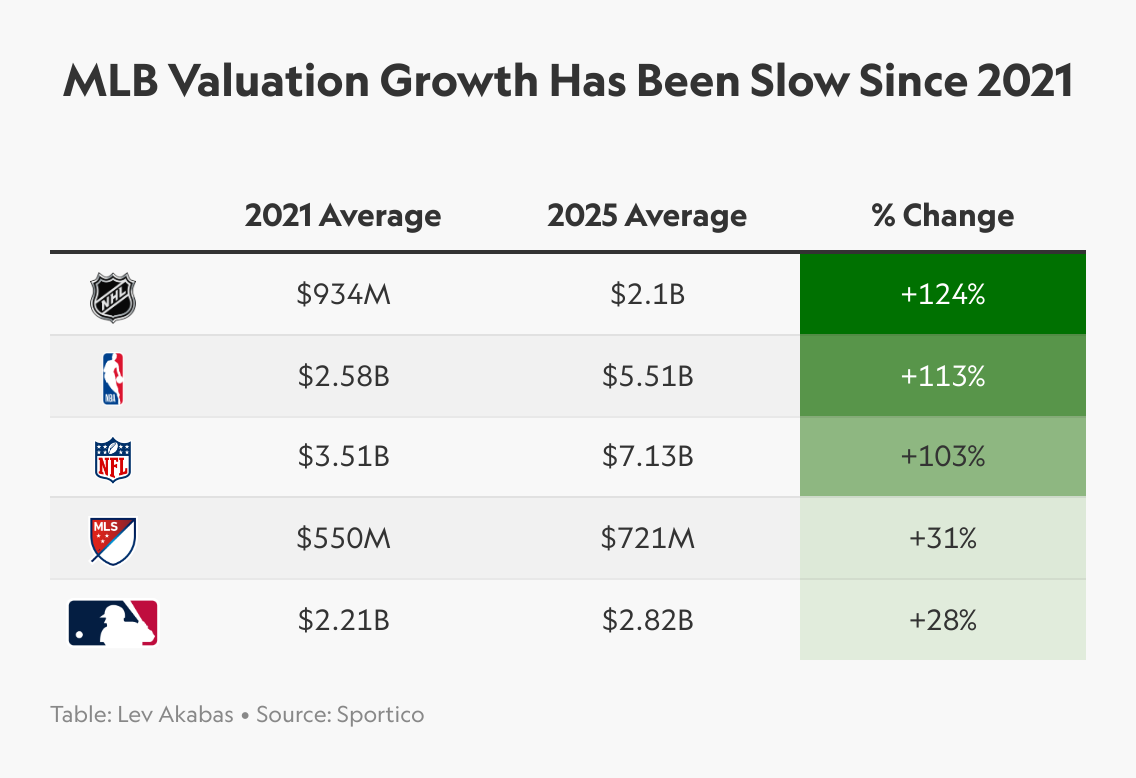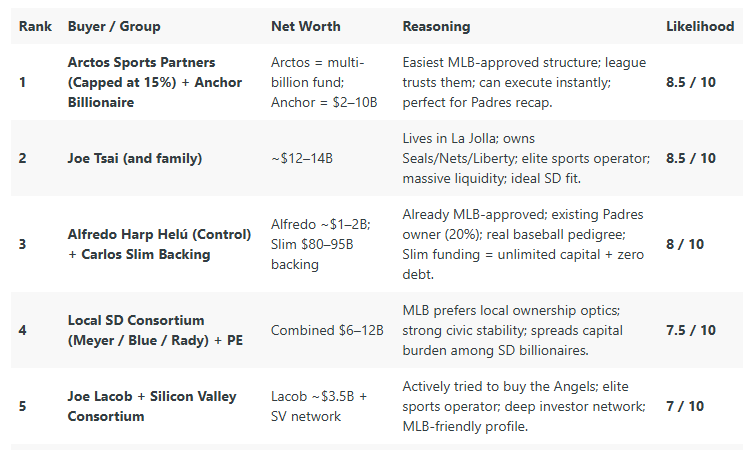Can you sell an MLB team today?
In the last few years, a number of MLB owners have tried—and failed—to sell their teams. Now, with a labor battle looming, the San Diego Padres are testing the waters
Welcome back to Club Sportico, where we break down the intersection of sports and money—with an extra bit of humor and opinion. Today, we’re assessing America’s Pastime.
On Thursday, Sportico dropped its latest franchise valuations with this wild stat: the average F1 team is now worth more than the average MLB team.
That’s partially a product of F1’s growth, but also comparative stagnancy in baseball. MLB franchises have appreciated, on average, just 28% since 2021. That pales in comparison to the other major U.S. leagues, where NHL, NBA and NFL valuations are all up more than 100%.
In that stretch, just two MLB teams have sold: David Rubenstein bought the Baltimore Orioles 🐤 in 2024, and Patrick Zalupski bought the Tampa Bay Rays 🏖️ in 20251. A larger number of teams—including the Los Angeles Angels 👼, Washington Nationals 🏛️ and Minnesota Twins👬—have tried to find a buyer, only to later change course.
Now, the San Diego Padres ⛪ have entered the fray. Locked in a legal battle over the wishes of deceased owner Peter Seidler, the team’s current stewards announced Thursday that they had retained a bank to explore a potential sale. Sportico values the franchise, which has spent lavishly to (unsuccessfully) compete for World Series titles, at $2.31 billion.
There’s no single reason for the false starts with the Angels, Nationals and Twins. Every situation, every market, and every seller is unique. But there is a common thread across them all. MLB is facing a dramatic overhaul of its local media economy, and the richest teams are spending more and more to distance themselves from everyone else. There’s also a potentially ugly labor fight looming after next season.2
That’s created a difficult pricing challenge for both sellers and buyers. Will there be a work stoppage in 2027? Will it end with a hard salary cap, which would make MLB teams significantly more valuable? How do you price the risk of the short-term pain and the long-term gain?
Former MLB star Alex Rodriguez, now an NBA/WNBA owner, was asked about this dynamic at a recent Sportico event. He gave an optimistic viewpoint, saying it was the “greatest time” to invest in the sport 👇
Our numbers are slightly different from Alex’s, but his comment about revenue multiples holds up. Sportico values the average NBA team at a 13.5x revenue multiple. NFL teams are at 10.3x, followed by MLS (9.4x) and NHL (8.4x). MLB teams come in at just 6.6x.
Last March I wrote here about my own conflicted feelings about MLB. That confusion persists. On the one hand, there are new rules, faster games and some amazing young stars; on the other, there’s a looming labor fight and virtually non-existent competitive balance.
For what it’s worth, there are a lot of smart people in our industry who agree with Rodriguez. I’m constantly asking folks where they see value amid runaway sports prices, and MLB has become a common answer. The next two years will likely be rough, yes, but there’s also a decent chance owners emerge on the other side with the kind of cost certainty that has driven appreciation in the NFL and, more recently, the NBA.3
The Padres will be an interesting test. The team hasn’t been able to compete with the rival Los Angeles Dodgers 🧢 in the biggest moments, but the Seidlers’ spending spree has created a very competitive franchise, and revenue has jumped in turn. Last year, the Padres finished second in MLB in attendance, and gross receipts topped $500 million. The team is comfortably in the top half of most valuable franchises, and worth significantly more than any of the other franchises that have sold in the past few years.
For now, Steve Cohen’s $2.42 billion purchase of the New York Mets 🚖 remains the most expensive MLB transaction ever. It’s certainly conceivable to think the Padres could sell for more than that. It’s also possible that, after gauging interest amid growing uncertainty, the process changes course. We’ve certainly seen that before.
One Fan’s 🔥 Take: Over on reddit, one Padres fans has created a long list of potential buyers and their upsides/downsides. This list is simultaneously awesome, wild and terrifying. Here’s a snippet:
On the most recent Sporticast episode—our 500th!—Scott and Eben spoke about Donald Trump’s visit to the Washington Commander, the first time in 50 years (!) that a sitting U.S. president went to a regular season NFL game. That turned into a conversation about the geographical advantages held by some sports teams 👇
Club Sportico is a community organized by Sportico, a digital media company launched in 2020 to cover the business side of sports. You can read breaking news, smart analysis, and in-depth features from Eben, Jacob and their colleagues at Sportico.com, and listen to the Sporticast podcast wherever you get your audio. Contact us at club@sportico.com.
In Tampa, the Lightning ($1.8 billion) recently sold for more than the Rays ($1.7 billion). A hockey team selling for more than a baseball team in a southern market “would have been unthinkable three years ago,” per our colleague Kurt Badenhausen.
No, the NBA doens’t have a hard cap like the NFL. But changes to basketball’s salary system, particularly around the “second apron” have created a de facto salary cap of sorts.








